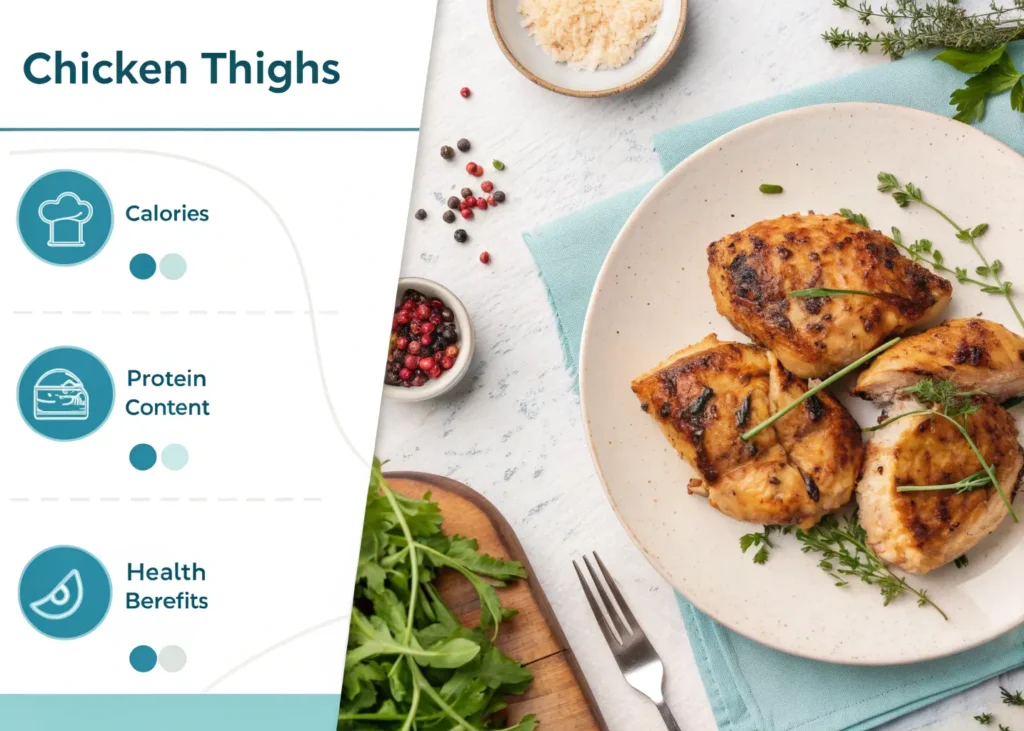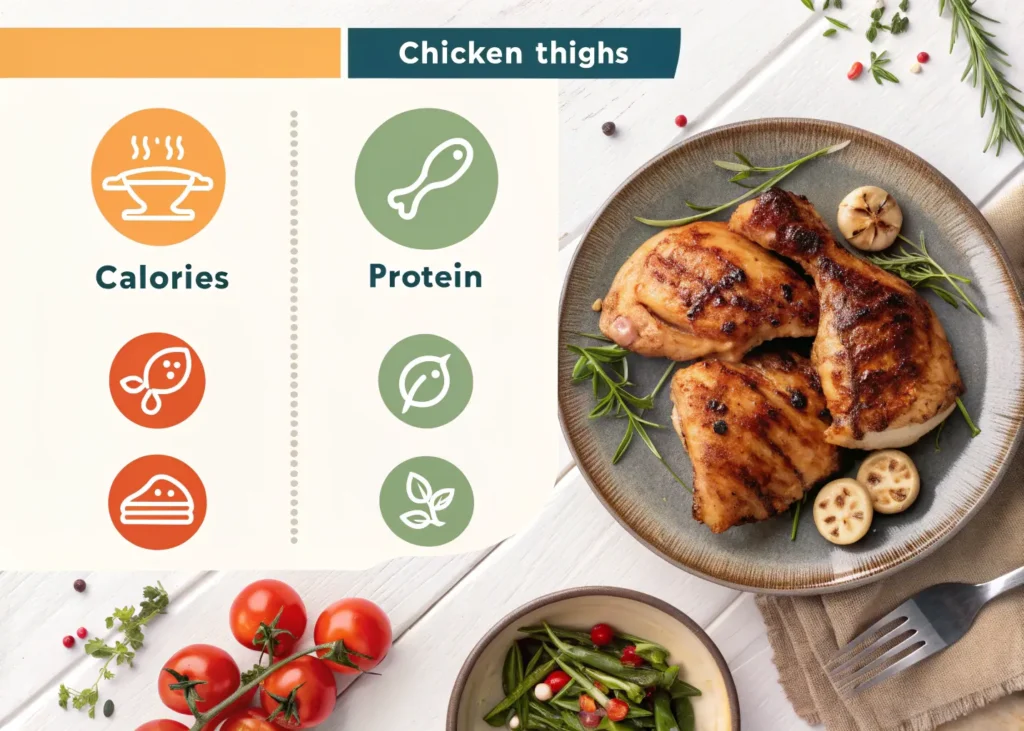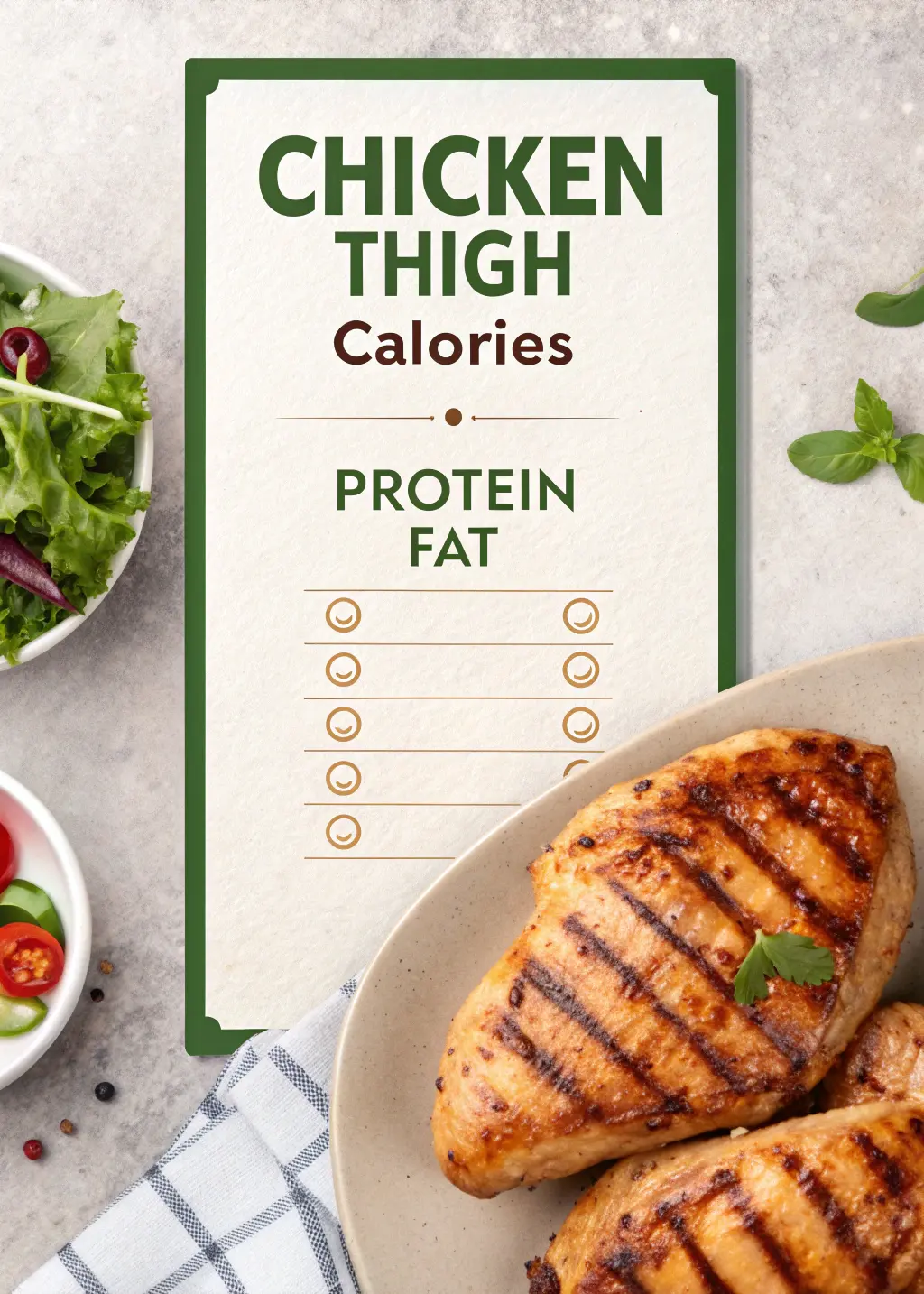The Complete Guide to Chicken Thigh Nutrition: Unlocking the Power of Dark Meat
Picture yourself standing in the grocery store’s meat section, scanning the poultry options with uncertainty. Your eyes drift between the familiar chicken breasts and those darker, more affordable thighs sitting nearby. Perhaps you’ve dismissed chicken thighs before, believing they’re somehow less nutritious than their leaner counterparts.
What if everything you thought about chicken thigh nutrition was wrong? What if these budget-friendly cuts actually pack more essential nutrients than the premium pieces you’ve been reaching for? Today, you’ll discover why nutrition experts are reconsidering the humble chicken thigh and how incorporating it into your meal rotation could transform your health—and your grocery budget.
Table of contents

Understanding Chicken Thigh Nutrition: Why Dark Meat Deserves Your Attention
When you examine chicken thigh nutrition closely, you’ll notice something remarkable happens in the darker meat. The richer color comes from higher concentrations of myoglobin, a protein that stores oxygen in muscle tissue. This biological difference creates a nutritional profile that’s distinctly superior in several key areas.
Your body benefits from the increased muscle activity in chicken thighs compared to breast meat. Since chickens use their leg muscles constantly for walking and movement, these areas develop higher concentrations of essential minerals and vitamins. This natural process creates what nutritionists call “nutrient density”—more beneficial compounds packed into every bite.
The fat marbling you see throughout chicken thigh meat isn’t just for flavor. These intramuscular fats serve as carriers for fat-soluble vitamins and provide sustained energy that keeps you satisfied longer than leaner cuts. Understanding this foundation helps you appreciate why chicken thigh nutrition offers unique advantages for your dietary goals.
Complete Chicken Thigh Nutrition Facts Breakdown
Calorie Content and Macronutrient Profile
When you choose skinless, roasted chicken thighs, you’re getting approximately 209 calories per 100-gram serving. This might seem higher than chicken breast, but consider what comes with those calories. You receive 27.4 grams of complete protein—containing all nine essential amino acids your body cannot produce on its own.
The fat content sits at 10.9 grams per serving, with the majority being heart-healthy monounsaturated fats. Unlike processed foods that deliver empty calories, chicken thigh nutrition provides what nutritionists call “functional calories”—energy paired with essential nutrients your body actively uses.
Your carbohydrate intake remains at zero, making chicken thighs perfectly compatible with low-carb eating approaches. This macronutrient profile creates stable blood sugar levels and sustained energy throughout your day.
Protein Quality That Supports Your Goals
The protein in chicken thigh nutrition stands out for its biological value—a measure of how efficiently your body can use the amino acids provided. With a biological value of 79, chicken thigh protein ranks among the highest-quality sources available.
You’ll find particularly high levels of leucine, an amino acid that triggers muscle protein synthesis. At 2.1 grams per 100-gram serving, chicken thighs provide enough leucine to stimulate muscle building and repair processes effectively. This makes them excellent choices for post-workout recovery meals.
The complete amino acid profile means you don’t need to combine chicken thighs with other proteins to meet your essential amino acid requirements. Your body receives everything it needs from this single source, simplifying meal planning while maximizing nutritional efficiency.
Essential Vitamins in Chicken Thigh Nutrition
B-Vitamin Powerhouse for Energy and Brain Health
Your nervous system and energy production depend heavily on B vitamins, and chicken thigh nutrition delivers these in impressive quantities. You’ll get 33% of your daily B12 needs in every 100-gram serving—crucial for nerve function and DNA synthesis.
The niacin (B3) content provides 39% of your daily requirements, supporting energy metabolism and maintaining healthy skin. Unlike synthetic supplements, these naturally occurring B vitamins come with cofactors that enhance absorption and utilization in your body.
Vitamin B6 contributes 29% of your daily needs, playing essential roles in brain development and immune system function. When you choose chicken thighs, you’re supporting multiple body systems simultaneously through this concentrated B-vitamin delivery.
Fat-Soluble Vitamin Enhancement
The natural fat content in chicken thigh nutrition creates an ideal environment for absorbing fat-soluble vitamins. While the meat itself contains modest amounts of vitamins A, D, E, and K, the fats present help you absorb these nutrients more effectively from other foods in your meal.
This synergistic effect means pairing chicken thighs with colorful vegetables creates enhanced nutritional absorption. Your body can better utilize the beta-carotene from sweet potatoes or the vitamin K from leafy greens when consumed alongside the healthy fats in chicken thighs.
Critical Minerals That Set Chicken Thigh Nutrition Apart
Iron Content for Energy and Vitality
One of the most significant advantages of chicken thigh nutrition lies in its iron content. You receive 1.3 milligrams of highly bioavailable heme iron per 100-gram serving—86% more than chicken breast provides.
This heme iron absorbs at rates between 15-35%, dramatically superior to the 2-20% absorption rate of plant-based iron sources. If you’ve struggled with low energy levels or iron deficiency, incorporating chicken thighs into your weekly rotation could make a measurable difference in how you feel.
Your body uses this iron immediately for oxygen transport through hemoglobin and energy production in cellular mitochondria. The result? More sustained energy throughout your day without the crashes associated with stimulant-based energy sources.
Zinc for Immune Function and Healing
Chicken thigh nutrition provides 2.9 milligrams of zinc per serving—nearly triple the amount found in chicken breast. This mineral supports over 300 enzymatic reactions in your body, making it essential for optimal health.
Your immune system relies heavily on adequate zinc levels for white blood cell function and antibody production. During times of stress, illness, or intense training, your zinc needs increase, making chicken thighs valuable additions to your recovery protocols.
The zinc in chicken thighs also supports wound healing, protein synthesis, and DNA repair processes. If you’re focused on building muscle, recovering from injury, or maintaining optimal immune function, this mineral density becomes particularly valuable.
Selenium: Your Antioxidant Protector
Each serving of chicken thigh nutrition delivers 27.6 micrograms of selenium—50% of your daily requirement. This trace mineral functions as a cofactor for glutathione peroxidase, one of your body’s most powerful antioxidant enzymes.
Your thyroid gland depends on selenium for proper hormone production and metabolism regulation. The selenium in chicken thighs supports healthy thyroid function while protecting against oxidative damage throughout your body.
Research suggests adequate selenium intake may support cancer prevention and cardiovascular health. By choosing chicken thighs regularly, you’re investing in long-term disease prevention through this essential mineral.

Health Benefits That Transform Your Wellbeing
Muscle Building and Athletic Performance
When you prioritize chicken thigh nutrition for muscle building, you’re choosing a protein source optimized for results. The combination of complete amino acids, particularly high leucine content, triggers muscle protein synthesis more effectively than many other protein sources.
The sustained energy release from the balanced protein-to-fat ratio prevents the energy crashes that can derail your training sessions. You’ll find yourself maintaining consistent energy levels throughout longer workouts, supporting better performance and recovery.
Your post-workout recovery improves when you include chicken thighs in your nutrition plan. The high-quality protein repairs muscle tissue while the minerals support the inflammatory response necessary for adaptation and growth.
Weight Management Through Satiety
Despite containing more calories than chicken breast, chicken thigh nutrition can actually support weight management goals through enhanced satiety. The protein content triggers release of hormones like GLP-1 and CCK that signal fullness to your brain.
The fat content slows gastric emptying, keeping you satisfied longer between meals. This natural appetite regulation reduces the likelihood of snacking on processed foods or overeating at subsequent meals.
Your metabolic rate increases through the thermic effect of protein—your body burns 25-30% of protein calories during digestion and absorption. This means chicken thigh nutrition actively supports calorie burning while providing essential nutrients.
Cardiovascular Health Considerations
The monounsaturated fat profile in chicken thigh nutrition supports heart health when consumed as part of a balanced diet. These fats help improve cholesterol ratios and reduce inflammation markers associated with cardiovascular disease.
Research indicates that replacing refined carbohydrates with high-quality protein and healthy fats—like those found in chicken thighs—improves multiple cardiovascular risk factors. Your blood pressure, triglyceride levels, and inflammatory markers may all benefit from this dietary shift.
The niacin content supports healthy cholesterol production and blood vessel function. Rather than avoiding chicken thighs due to fat content, consider them valuable contributors to a heart-healthy eating pattern when prepared properly.
Brain Health and Cognitive Function
Your brain requires steady supplies of B vitamins, iron, and quality protein to function optimally. Chicken thigh nutrition provides all these elements in bioavailable forms that cross the blood-brain barrier effectively.
The vitamin B12 content supports myelin sheath maintenance around nerve fibers, crucial for signal transmission speed and accuracy. Deficiencies in B12 can lead to cognitive decline, making regular intake through foods like chicken thighs important for long-term brain health.
Iron deficiency affects cognitive performance, particularly attention and memory. The heme iron in chicken thighs helps maintain optimal brain oxygen levels, supporting clear thinking and mental energy throughout your day.
Maximizing Chicken Thigh Nutrition Through Smart Preparation
Cooking Methods That Preserve Nutrients
Your cooking approach significantly impacts the nutritional value you derive from chicken thighs. Gentle, moist-heat methods like braising and slow cooking preserve the most vitamins while breaking down tough connective tissues into beneficial gelatin.
When you braise chicken thighs, you create an environment that maximizes mineral retention while developing complex flavors. The low, slow cooking process transforms collagen into gelatin, providing additional protein and supporting joint health.
Roasting with the skin initially protects fat-soluble vitamins from oxidation, even if you remove the skin before eating. The rendered fat bastes the meat naturally, maintaining moisture and preventing the formation of harmful compounds that occur with high-heat, dry cooking methods.
Nutrient-Enhancing Food Combinations
Pairing chicken thigh nutrition with specific foods amplifies the health benefits you receive. Combining chicken thighs with vitamin C-rich vegetables like bell peppers or tomatoes enhances iron absorption significantly.
Your body absorbs more beta-carotene from orange vegetables when consumed with the healthy fats in chicken thighs. This synergy means dishes combining chicken thighs with sweet potatoes or carrots provide superior nutritional value.
Adding herbs like rosemary, thyme, or oregano contributes antioxidants that work synergistically with the selenium in chicken thighs. These combinations create meals that actively fight inflammation and oxidative stress.
Addressing Common Concerns About Chicken Thigh Nutrition
Cholesterol and Saturated Fat in Perspective
You might worry about the cholesterol content in chicken thighs, but current research reveals that dietary cholesterol has minimal impact on blood cholesterol for most people. Your liver produces 75% of your body’s cholesterol, adjusting production based on dietary intake.
The saturated fat content (5.2 grams per 100-gram serving) fits comfortably within current dietary guidelines when chicken thighs are part of a balanced eating pattern. Focus on the overall quality of your diet rather than eliminating individual foods based on single nutrients.
Recent studies suggest that saturated fats from whole food sources like chicken thighs may have different metabolic effects than those from processed foods. The protein and mineral content in chicken thighs provides nutritional context that processed foods lack.
Calorie Density and Portion Control
While chicken thighs contain more calories than chicken breast, the enhanced satiety they provide often leads to smaller portion sizes naturally. You’ll likely find yourself satisfied with 4-5 ounces of chicken thigh compared to larger portions of leaner proteins.
The key lies in mindful eating and paying attention to hunger and fullness cues. The rich flavor and satisfying texture of chicken thighs make it easier to eat slowly and recognize when you’ve had enough.
Your long-term success depends more on dietary adherence than perfect macro ratios. If chicken thighs help you enjoy healthy eating and stick to your nutrition plan, they’re supporting your goals even if they’re not the lowest-calorie option.
Practical Integration Strategies
Weekly Meal Planning with Chicken Thighs
Incorporating chicken thigh nutrition into your routine becomes simple with strategic meal planning. Aim for 2-3 servings per week, rotating with other protein sources to maintain dietary variety.
Batch cooking chicken thighs on weekends provides convenient protein for busy weekday meals. You can prepare them using different flavor profiles—Mediterranean herbs, Asian marinades, or Mexican spices—to prevent meal fatigue.
Your grocery budget benefits significantly from choosing chicken thighs over premium cuts. The money saved can be invested in higher-quality vegetables, herbs, and other nutritious ingredients that complement the chicken.
Storage and Preparation Tips
Fresh chicken thighs maintain optimal nutrition when used within 1-2 days of purchase. If you’re batch cooking, freeze portions in meal-sized quantities to preserve nutrient content and prevent waste.
Thawing frozen chicken thighs in the refrigerator maintains food safety while preserving nutritional integrity. Avoid microwave thawing, which can create hot spots that begin cooking the meat unevenly.
Marinating chicken thighs before cooking adds flavor while potentially providing additional antioxidants from herbs and spices. Acidic marinades with citrus or vinegar may also help tenderize the meat naturally.

Conclusion: Embrace the Nutritional Power of Chicken Thighs
Your journey toward optimal nutrition doesn’t require expensive superfoods or complicated meal plans. Sometimes, the most powerful changes come from recognizing the value in foods you’ve overlooked. Chicken thigh nutrition represents exactly this kind of opportunity—a chance to improve your health, satisfy your taste preferences, and manage your budget simultaneously.
The evidence speaks clearly: chicken thighs deliver superior mineral content, excellent protein quality, and beneficial fats that support multiple aspects of your health. From muscle building and immune function to brain health and heart protection, these affordable cuts provide comprehensive nutritional support.
Your next grocery trip presents an opportunity to make a change that ripples through every aspect of your health. Choose chicken thighs not as a compromise, but as a strategic decision for better nutrition, enhanced satisfaction, and sustainable healthy eating.
Ready to transform your nutrition with chicken thighs? Start this week by replacing one chicken breast meal with properly prepared chicken thighs. Notice how the enhanced flavor and satisfaction affect your overall eating experience. Your body—and your wallet—will thank you for making this simple but powerful switch. Share your favorite chicken thigh preparation methods in the comments below and inspire others to discover this nutritional goldmine.
Have you given our recipe a try?
There are no reviews yet. Be the first one to write one.







